Although not among the favourites for this competition, Japan goes into the Olympics in good form, having tasted various levels of success in 2023 and 24.
Nadeshiko Japan, currently managed by Futoshi Ikeda, beat Korean DRP in the final to win the 2023 Asian Games, and they came close to more silverware when it came to the World Cup and the SheBelieves Cup—finishing fourth in the latter and getting knocked out at the quarter-finals in the former.
They qualified for this tournament by winning Asia’s qualifying competition, beating Korean DPR over two legs in the final.
Since the SheBelieves Cup, Japan has played two friendlies, beating New Zealand comfortably both times.
They are also scheduled to play Ghana in a friendly match in July as they continue their Olympics preparation.
This preview provides a Japan WNT tactical analysis of Japan’s tactics in the past year—the key elements of their strong attacking game, the tactics behind their defensive approach, their work in transitions, and various squad selection discussion angles.
Predicted Starting XI
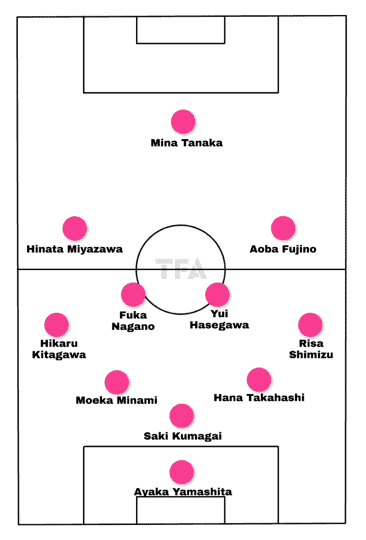
Japan have opted for a 5-4-1 more often than not in the past year, but their approach is less defensive than the formation sounds! As we will explain later in the analysis, a well-balanced system allows their full-backs to push forward in possession to provide width to the narrow midfield four, which is set to be full of big names Manchester United’s Hinata Miyazawa, Manchester City’s Yui Hasegawa, Beleza’s Aoba Fujino, and Liverpool’s Fuka Nagano.
Japan can switch the formation to 4-1-4-1, allowing them to keep the same attacking lineup in midfield.
Mina Tanaka will lead the front line in either formation.
At the back, Saki Kumagai is a likely starter in the heart of the defence, alongside Hana Takahashi and Moeka Minami – Hitaru Kitagawa and Risa Shimizu are set to start in those full/wing-back roles.
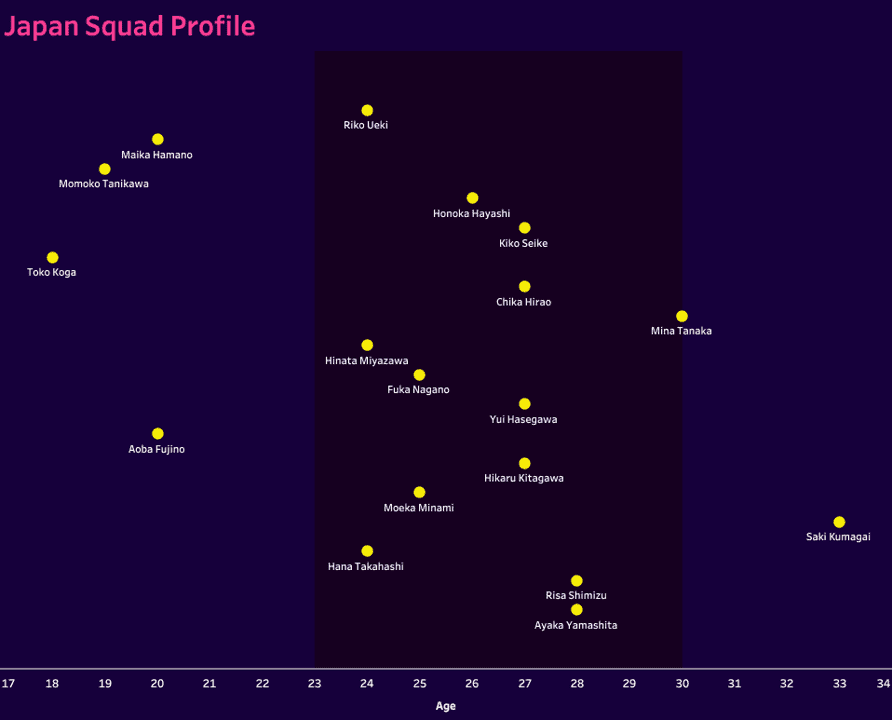
In terms of the age profile, the Japan squad primarily consists of players in and around their prime years, with just two players aged 30+ being involved.
On the flip side, four U23 players have been included in the squad, including 18-year-old Tōko Koga.
Various WSL starts feature in the squad, with many in the prime stages of their respective careers.
Attacking Phase
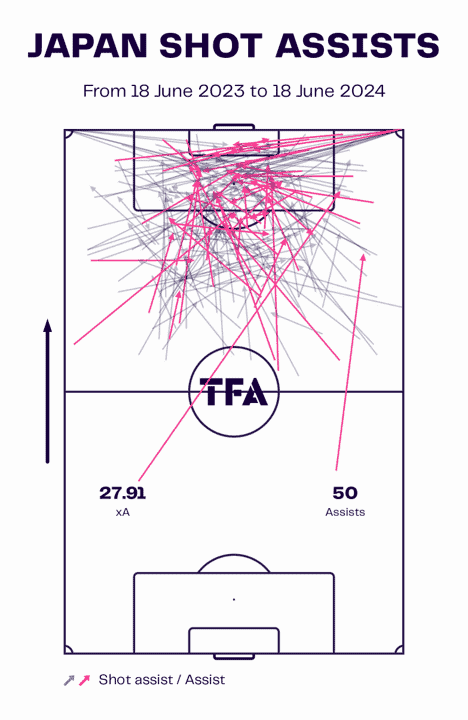
In the past year, Japan have had some good form in front of goal, scoring 3.7 goals per 90.
Many of those goals and various other chances originated from build-up play in central areas, as you can see from the visual above.
Another noteworthy element of their chance creation is the strength of their right-flank attack, where they tend to create/assist on a more regular basis than they do on the left-flank.
They are a dangerous team in the final third, a team that plays with confidence and precision.
In the past year, Japan has averaged 16.3 shots per 90 minutes, with an impressive accuracy rate of 46.9%.
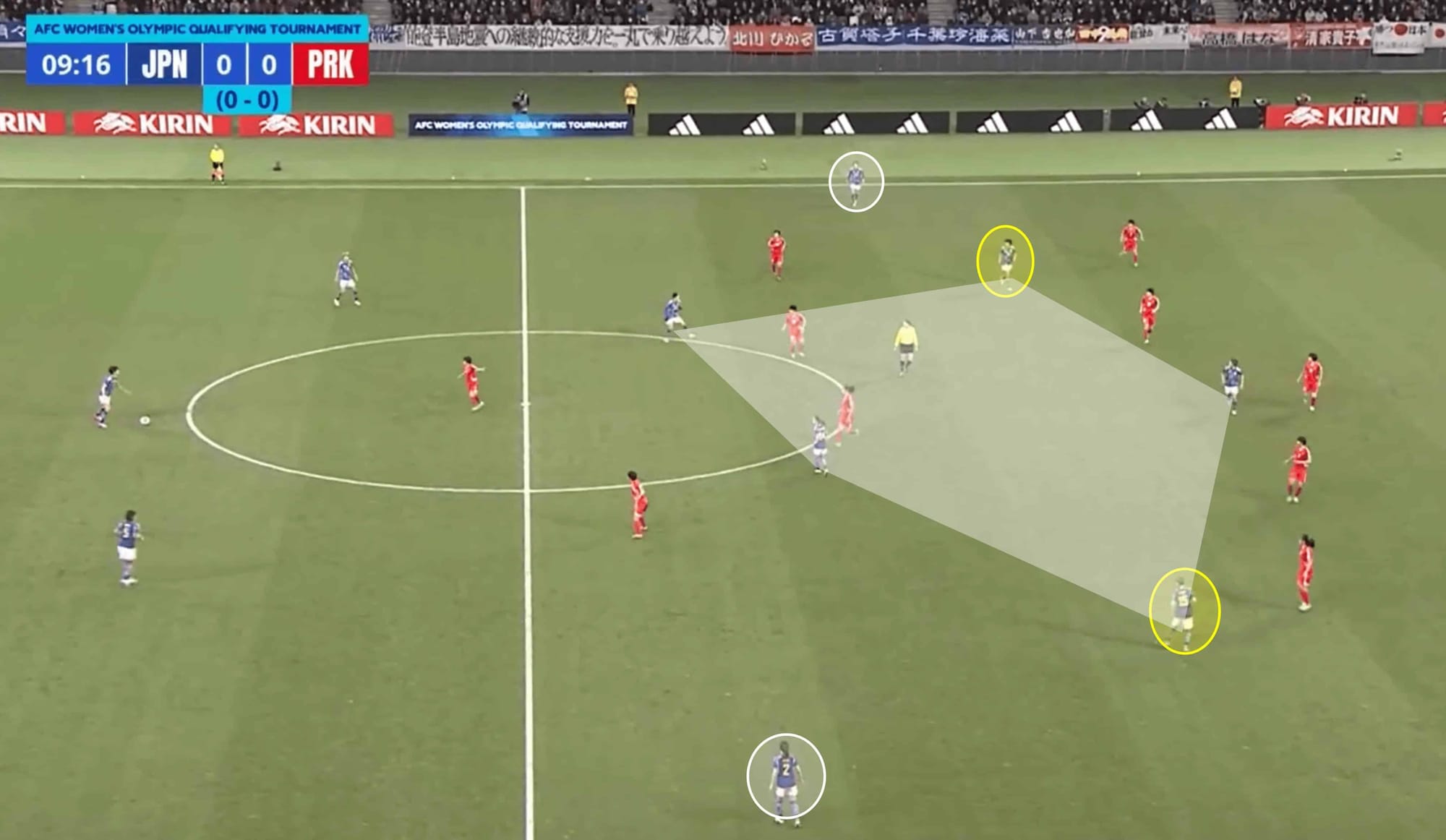
While Japan don’t tend to dominate every game in terms of possession, their in-possession approach shows clever positional details that allow them to assert dominance in select areas of the pitch.
The full-backs are often seen to be high and wide in possession, with the wide midfielders tucking inside.
Japan’s shape in this regard is interesting; there is plenty of freedom and fluidity between the midfield four, where they eventually look for clever off-the-ball movements and passing combinations.
There is also an element of strong chemistry and link-up play between the full-back and wide midfielder, particularly on that right flank.
The left centre-back and right centre-back stay alongside the middle centre-back instead of pushing into higher/wider positions, which lends itself to defending in transitions.
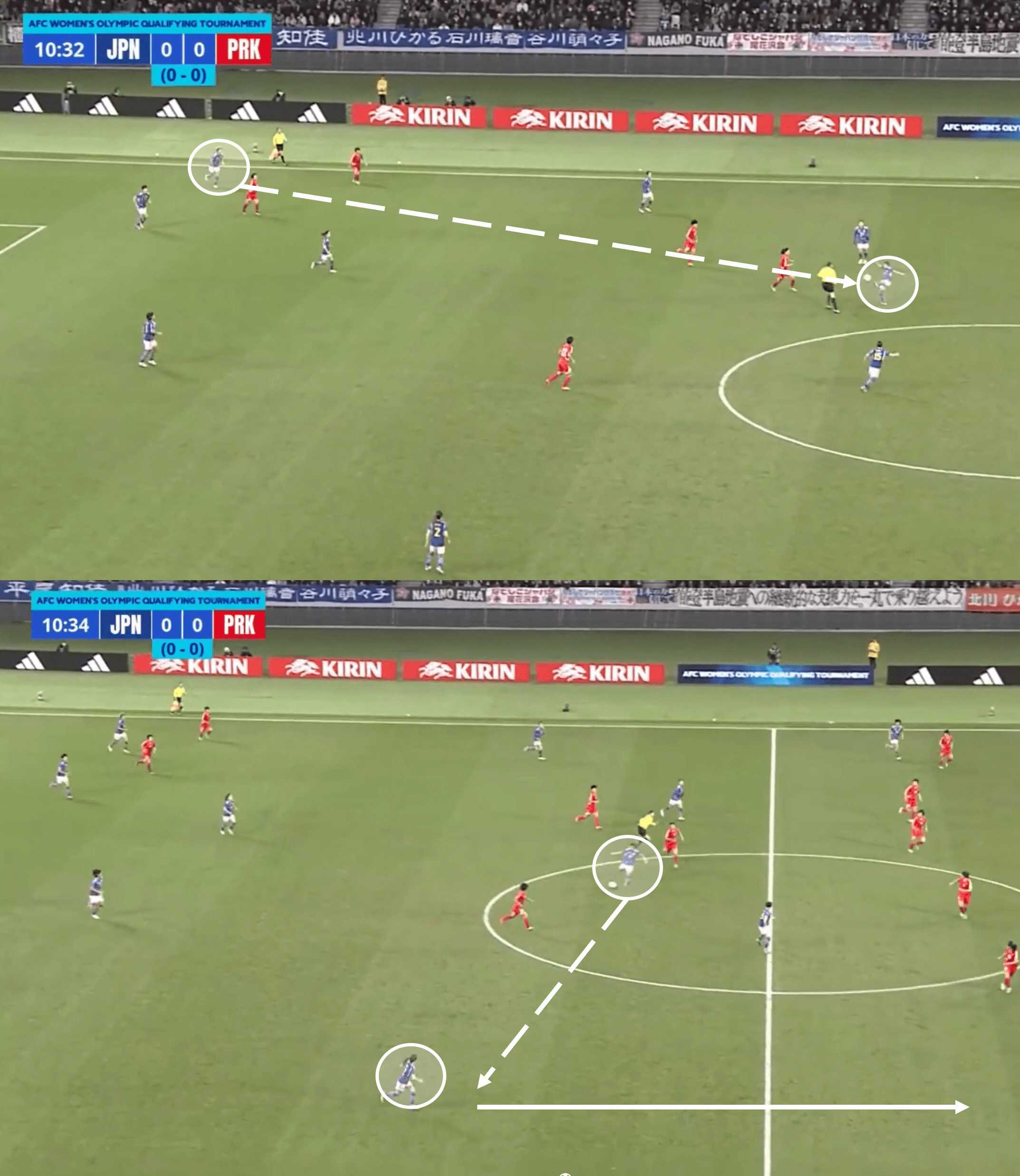
A critical element of their in-possession approach is the use of progressive passes – in the last year, they’ve averaged 87.35 prog passes per 90, with a tremendous accuracy of 71.5%.
The application of this pass type again uses elements of that central focus in attack, as seen before, where they look to take advantage of the numbers game and any empty space.
On some occasions, like in the example above, they use those moments in the middle to move the ball out to the opposite flank.
The speed of that build-up segment (progressive pass into the middle) means they can bypass the opposition and shift the ball into dangerous space.
Defensive Phase
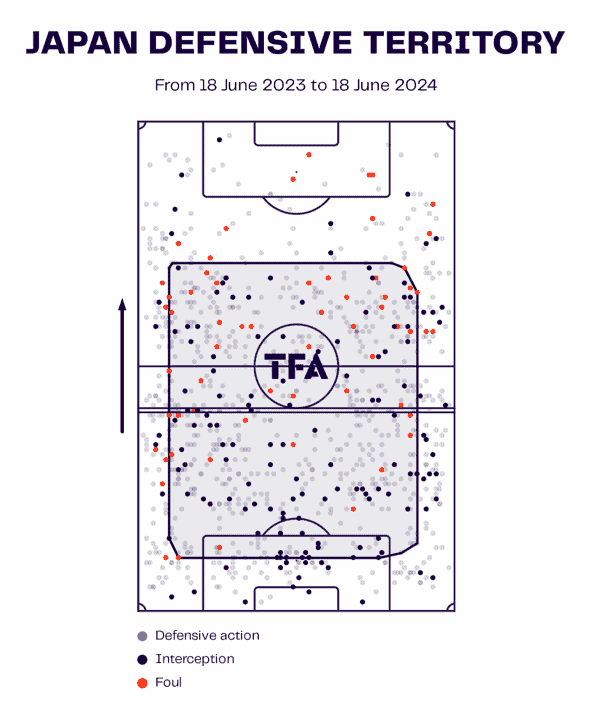
Japan tend to be fairly well-balanced in their defensive approach – they don’t sit back but they’re also not an all-out pressing machine.
As you may guess, the bulk of their defensive work (in their own half) happens in central areas.
In the opposition half, they are more active in wide areas, especially in breaking up play.
As the map above does show, they are less active in the final third in terms of shutting the opposition down.
Their PPDA over the last year averages at 10 per game – while this is usually a sign of high aggression, Japan tend to save that higher intensity for games in which they are the much stronger team.
Overall, their defensive record in the past year has been fairly decent, conceding 0.85 goals per 90, facing just 6.95 shots per 90.
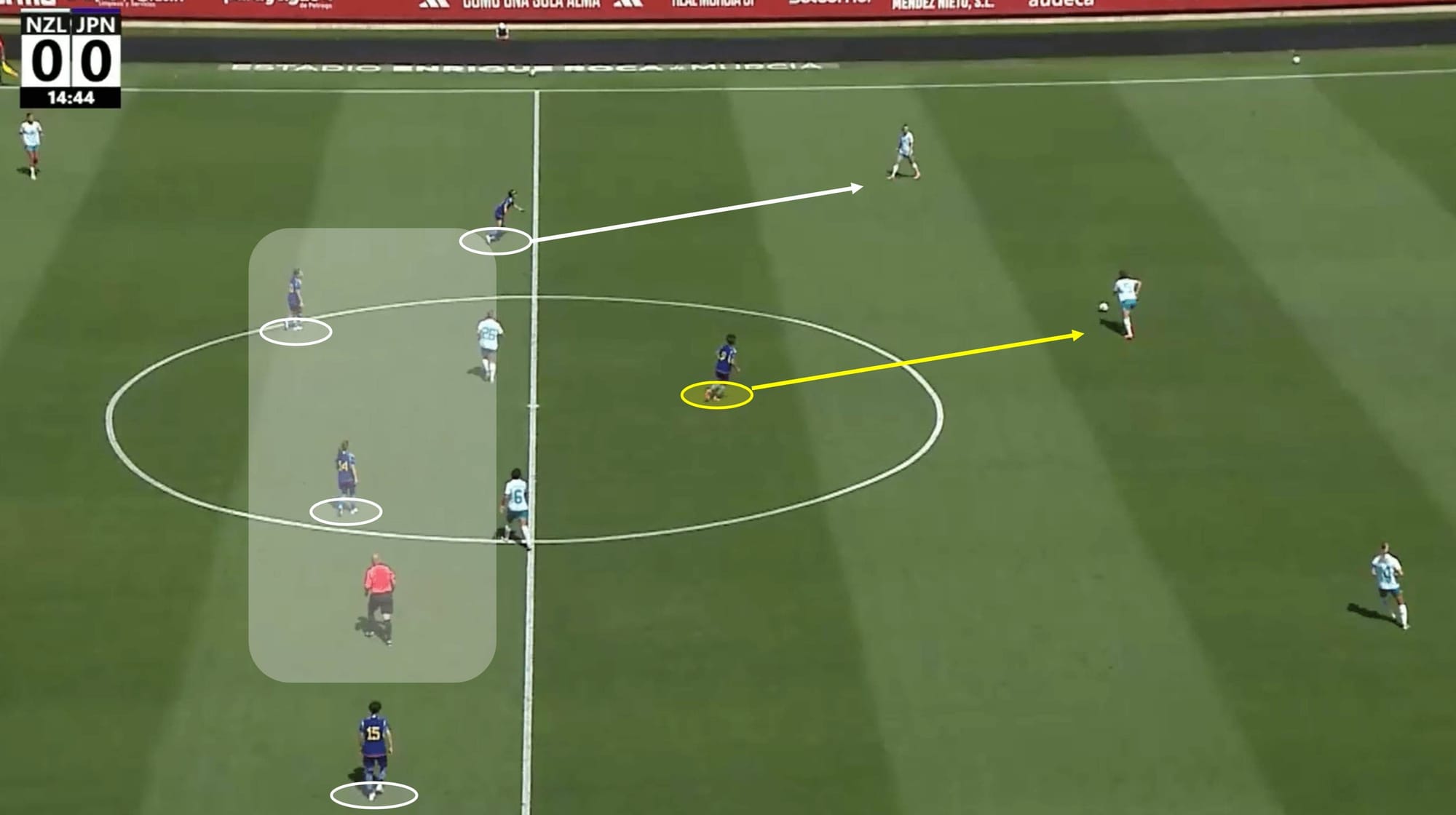
This is an example of said caution in their off-the-ball approach.
The midfield unit will often be positioned high, close to the forward, with a narrow shape to it – the aim here is to protect central areas and block those early penetrating passes.
They will execute a press when certain triggers become visible—namely, the opposition’s hesitation to go forward.
Furthermore, they each have individual roles in the press—as seen above.
As the ball is passed to the right back, Japan’s left midfielder will press, while the forward will go and mark the nearest centre-back option.
This gives the opposition limited choices in terms of the next pass.
Transitions
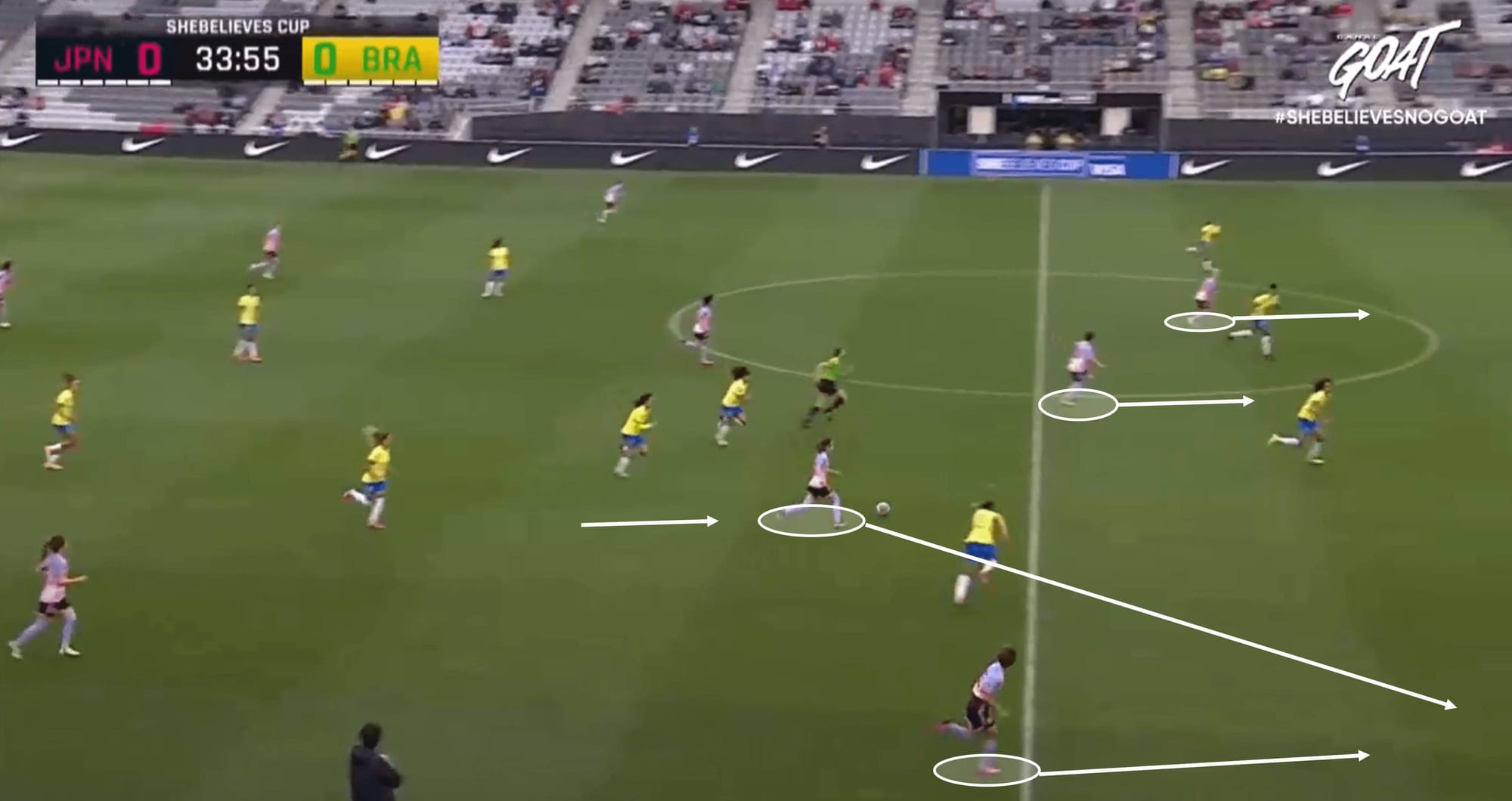
Counterattacking football isn’t something you should expect to see too much of from Japan this year, but they know how to utilise key moments in attacking transitions when the opportunity presents itself.
They can be seen to be more reserved in some transitions and hold onto possession, but if there is a strong chance of a break, like the example above, they’ll go for it.
This includes runners scattered across various locations on the front line as they look to create spaces in the opposition defence – the individual technical ability in midfield also plays a vital role in getting the ball into more dangerous positions.
One area to they need to be careful of, though, is those transition moments deep inside their own half against a team that likes to press high.
Japan have shown some signs of difficulty in dealing with these scenarios from time to time, so making sure they know when just to clear the danger could play an important role.
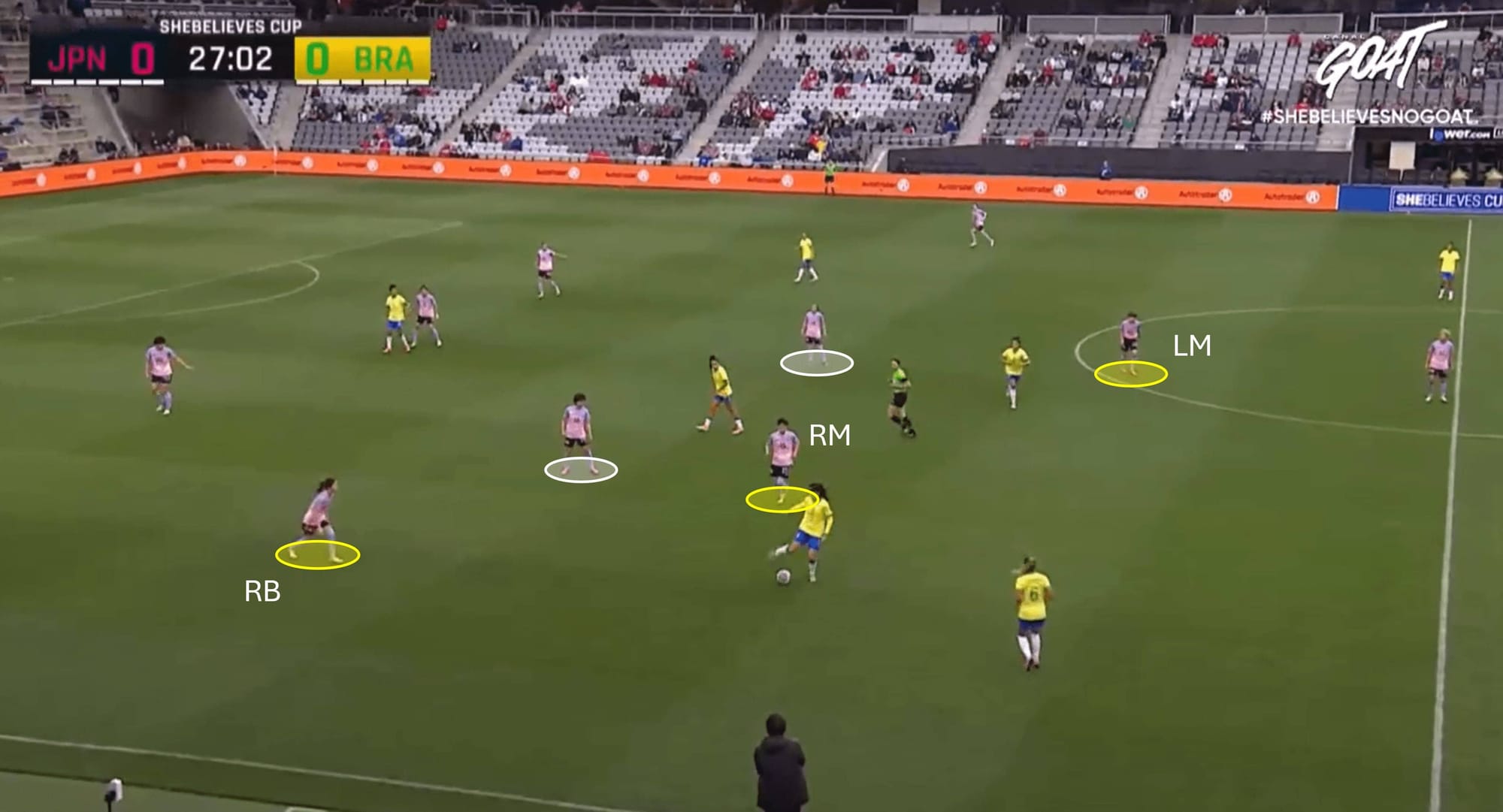
In defensive transitions, they often look to regroup, particularly in their own half.
Earlier, we mentioned how their wide midfielders frequently tuck inside; well, this lends itself to defensive transitions as they can create a central barrier along with the centre midfielders.
Counterpressing isn’t something we see all too often from this Japan side, but that doesn’t mean they never utilise it.
The right-back is an excellent example of this – she opts to wait and sit in line with her central midfield teammates rather than charge out and close the ball down, which falls in line with Japan’s defensive tactics.
Forwards
As we mentioned, 30 Y/O Mina Tanaka is expected to lead the line for Japan in the Olympics.
Her pace and energy can be a handful for the opposition backline, and her ability to link up with the midfield can also be dangerous.
With her in the squad is the Chelsea forward Maika Hamano and West Ham’s Riko Ueki, giving Japan the luxury of strong depth in that position.
Both backup options have featured for Japan over the past year, but it is believed that Ikeda will opt for the more experienced Tanaka.
Midfielders
We mentioned our expected starting midfield four, but they also have three options deeper in the squad, two of which are in their prime years.
Kiko Seike (Urawa Reds) and Honoka Hayashi (West Ham United) provide that experience from the bench (or in squad rotation).
At the same time, 19-year-old Momoko Tanikawa of Rosengård who has scored an incredible 10 goals in 9 appearances in the Damallsvenskan.
The teenager made her Japan debut last year, and will be looking to continue her strong career start in a big way.
Defenders
Interestingly, just six defenders have been named in Ikeda’s Olympic squad.
As Japan is expected to field a 5-4-1 formation, that leaves just one rotation/back-up option on the bench—that option is the youngest player in the whole squad: Feyenoord’s Tōko Koga.
She is primarily a central defender, and can play on either side of that role, as well as in the middle, meaning she could replace any of Minami, Kumagai, or Takahashi.
Additionally, Koga has experience playing at right-back, so she does bring an element of versatility to the back four/five.
Key Player
Japan’s squad is abundantly quality-rich, and any number of players could be crucial in “make or break” scenarios.
However, we’re going to spotlight one player who has demonstrated excellent technical ability, ball progression, and tactical awareness in Japan’s midfield: Liverpool’s Fuka Nagano.
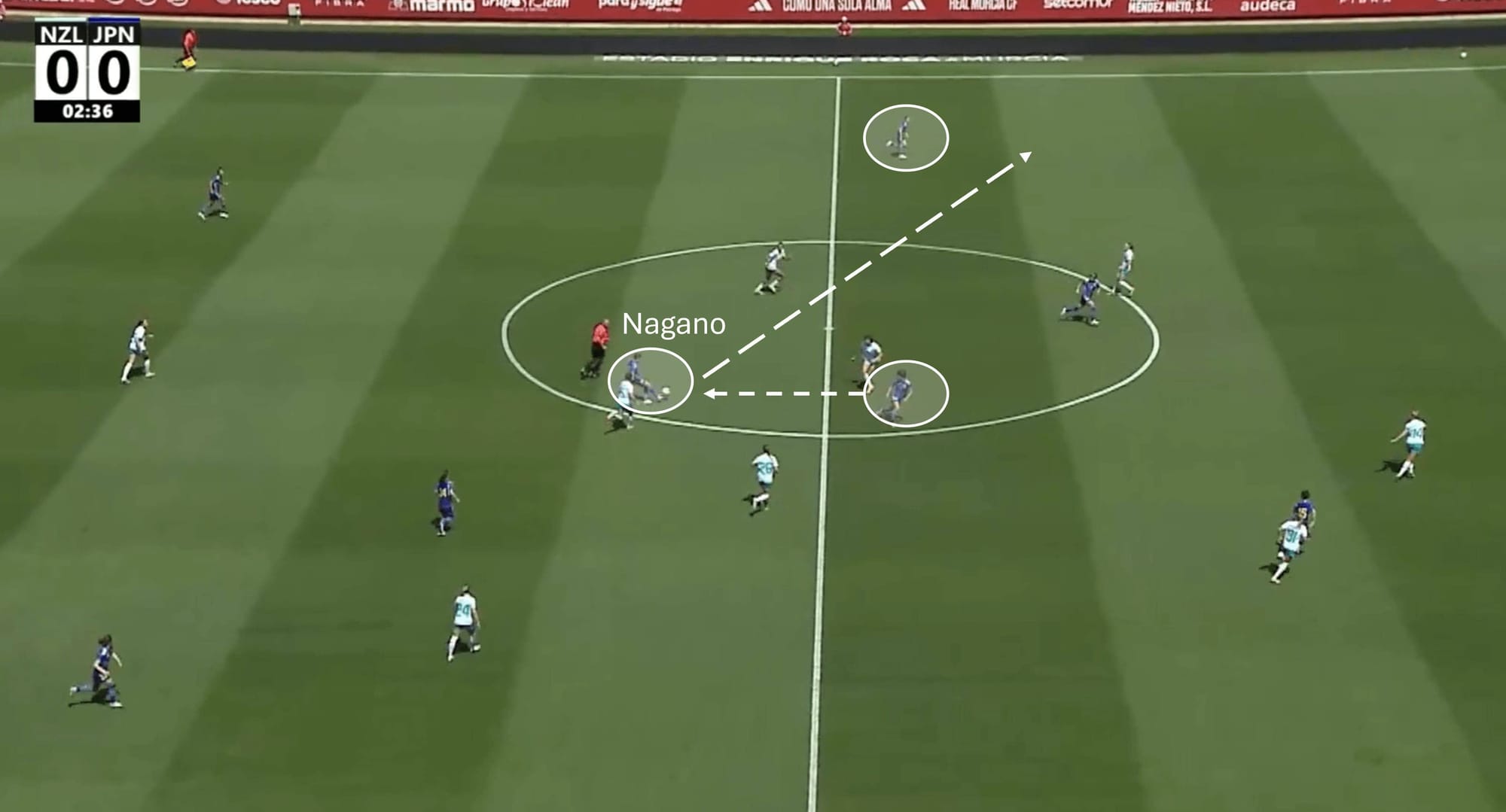
The 25-year-old is expected to start in one of Japan’s central midfield roles, and she brings great on-the-ball composure and ” outside-the-box” thinking.
She shows good scanning abilities and the skill to pull off a range of difficult and/or important passes.
In that sense, she plays a significant role in Japan’s tactics when it comes to progressive passes, an element that we highlighted earlier.
An example of her role in those tactics lies above.
She shows the vision, composure, and technical execution to provide a perfect first-time lofted pass into space on that left flank.
While this may look like a simple decision and action, her initial movement and scanning made it so easy—her technical ability sees to the rest.
Nagano’s calming presence in deeper midfield regions and transitions can provide an added edge to Japan’s performance, and her creativity in higher areas can give her side an added dimension in attack as well.
Tournament Prediction
Japan’s group is a tough one – Spain, Brazil, and Nigeria await them.
Japan, currently seventh in FIFA’s world rankings, have had mixed success across three games against Brazil (9th in rankings) in the past year – one defeat, one win, one draw.
Spain are the current world number one and the favourites for this tournament, so Japan will have to be at their very best to get a positive result in that one – may also see a more defensive approach from Ikeda in this game.
36th-ranked Nigeria will be hoping to cause an upset by claiming the scalp of any of these three teams, but Japan will look to be focused on claiming all three points to ease the pressure.
Japan are not among the favourites (Spain, the USA, and France are the top three favourites), but they will be pleased by their progress over the last year and will look to use that momentum to have a positive tournament.
If they can get out of that very tricky group, which is hard to predict, that will only fuel their momentum and desire.
Reaching the semi-final is not over-ambitious, but they have to be aware of the sheer quality that lies within the tournament.

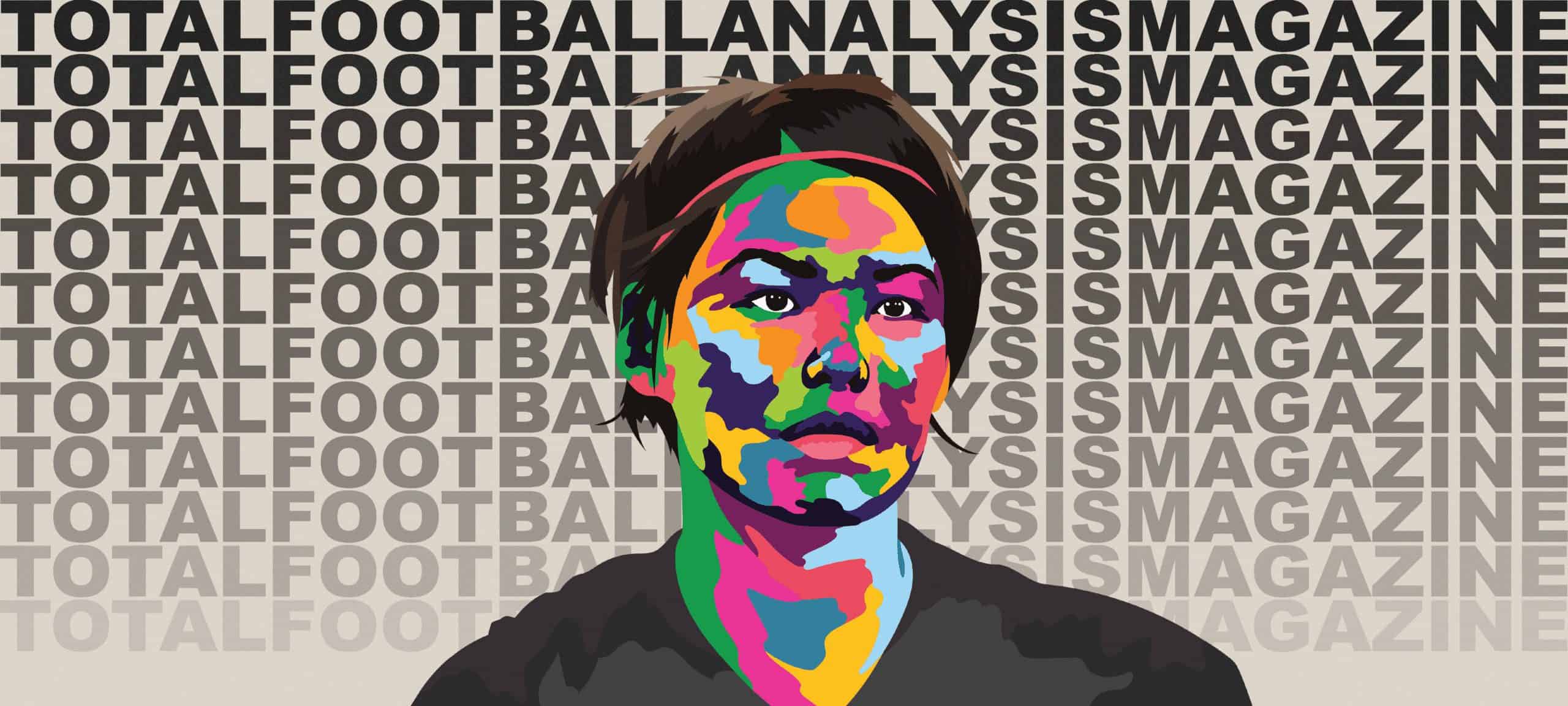



Comments